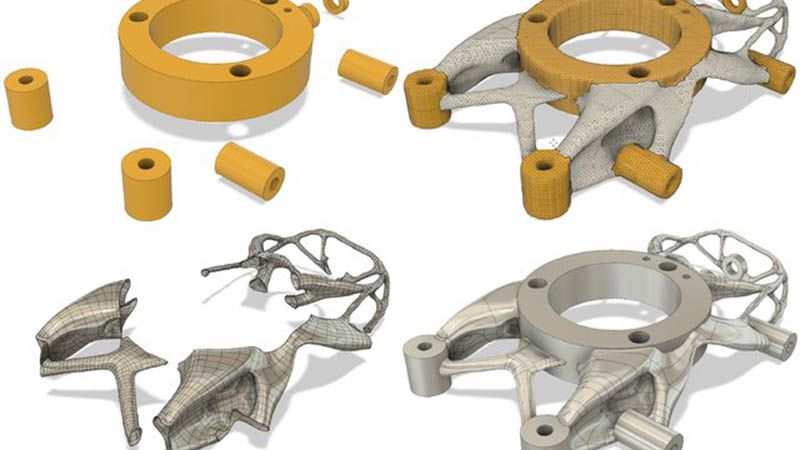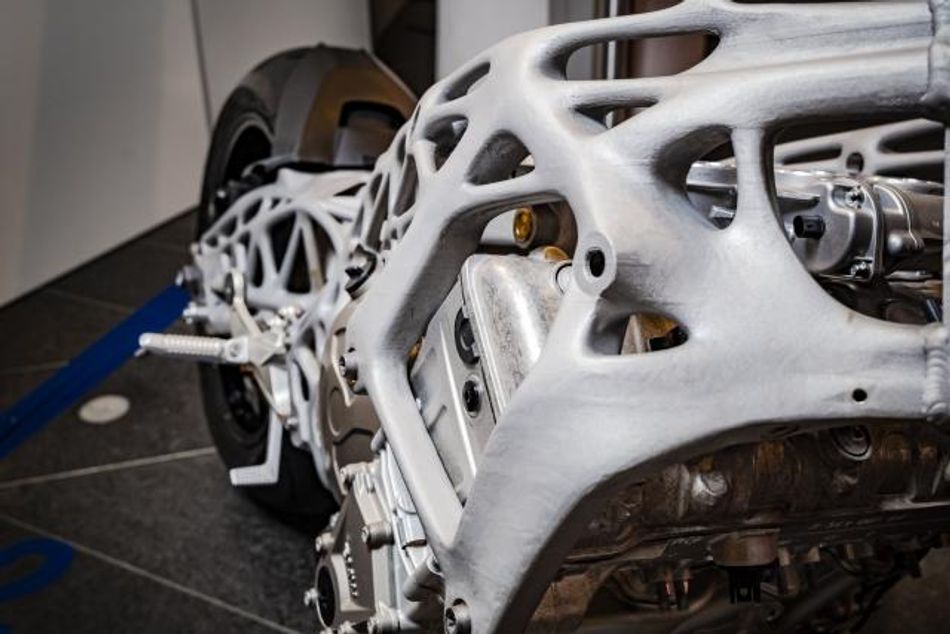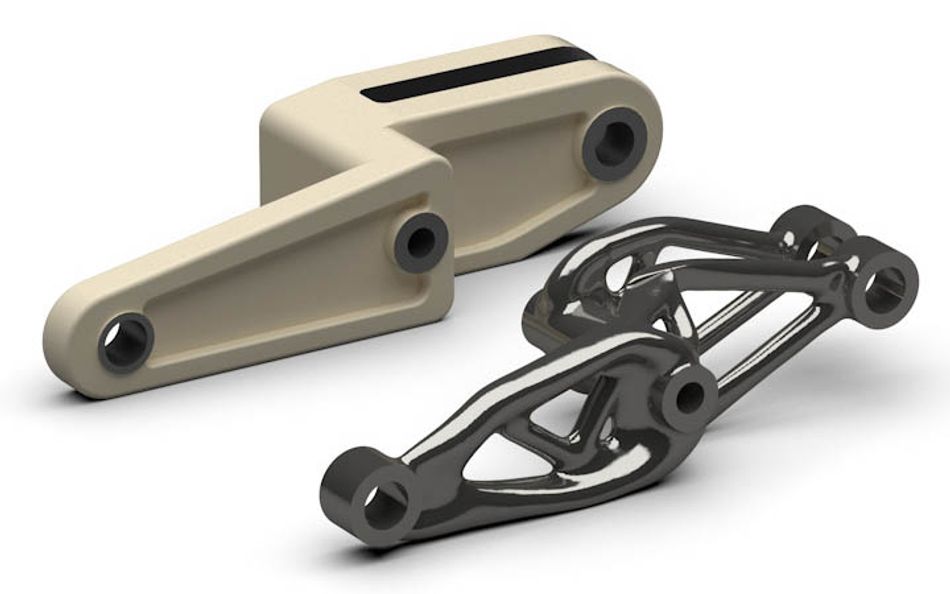Real-time generative design for transportation lightweighting
Advanced software optimizing the weight of vehicles accelerating decarbonization.

Image credit: Martin Cvetanov Marinov
Tags
Together with Ansys, a developer of simulation software, we are creating a series of content about the technologies that make sustainable transportation possible. Read the foundation article of the series here, and our introduction to the Indy Autonomous Challenge here.
Introduction
The focus of transportation industries must move towards decarbonization. To reach this objective, lightweighting, or reducing the total weight of a vehicle, usually by reducing the weight of individual parts without reducing the global strength, can be improved by generative design. Generative design is an iterative design process where advanced simulation assists in creating a design based on a set of parameters and objectives. Generative design does not offer a single best solution but a range of design options to solve complex challenges.
The quest for lighter, stronger vehicles
Reducing the weight of vehicles is crucial to increasing efficiency. This has come into even sharper focus with the rise of electric vehicles that must balance heavy battery systems while still achieving useful range. One method is through a technique known as lightweighting. Lightweighting reduces the overall weight of different parts by using design.

Nature-inspired no-waste design
Generative design is a relatively new approach that sees engineers input design goals such as lightweighting into software along with other parameters such as manufacturing methods and performance requirements. Unlike other design methods, generative design does not require a starting geometry. The users input the areas that the part must keep and identify which areas that material should not enter. Then the performance requirements are inputted; these can include constrained areas, forces, and pressures on the part, etc.). Following this, other inputs can be added, such as the possible materials and any manufacturing restraint, such as minimum wall thickness or the drill bit size for CNC, etc. The advanced software then combines simulation with design algorithm to create valid geometry solutions to the defined design problem.
The result of each pass is the entry point for the next iteration. Each step is available for the designer to view and they can modify the constraints to direct the evolution of the design. At the end of the generative design, they can compare the several solutions and decide on which one to pursue. A significant difference of generative design is that designers can start the process with relatively lean resources. Computations are fast and can be influenced in real-time cutting design process times significantly.
 Figure 2: The output of generative design often mimics forms found in nature such as bones and tree growth. Image credit: procestechnologiczny.Generative design partners with additive manufacturing
Figure 2: The output of generative design often mimics forms found in nature such as bones and tree growth. Image credit: procestechnologiczny.Generative design partners with additive manufacturing
 Figure 2: The output of generative design often mimics forms found in nature such as bones and tree growth. Image credit: procestechnologiczny.
Figure 2: The output of generative design often mimics forms found in nature such as bones and tree growth. Image credit: procestechnologiczny.The manufacturing process also influences design. Automotive design has traditionally relied heavily on casting and molding manufacturing. Due to these processes’ high set-up costs, they have generally been slow to change (hence why much of the internal combustion car hasn’t changed form significantly over the last decades). Generative design lends itself to the agility and lower cost of additive manufacturing such as 3D printing. Although the complexity of the designs may be suitable for 3D printing, the automotive industry and other manufacturing spaces are still working on ways to scale up the use of 3D printing for final parts. However, 3D printing in prototyping and design iterative is being widely adopted to reduce their traditionally long design leads.
 Figure 3: The Vertebrae Indicator Bracket by Evol Components printed by PolySpectra. Image credit: Ken FlipponiDelivering zero carbon transport
Figure 3: The Vertebrae Indicator Bracket by Evol Components printed by PolySpectra. Image credit: Ken FlipponiDelivering zero carbon transport
 Figure 3: The Vertebrae Indicator Bracket by Evol Components printed by PolySpectra. Image credit: Ken Flipponi
Figure 3: The Vertebrae Indicator Bracket by Evol Components printed by PolySpectra. Image credit: Ken FlipponiThe European Commission has set a goal of carbon-neutrality for 2050 with an intermediate target of at least 55% net reduction in greenhouse gas emissions by 2030[1] . These goals must be applied to all industries. The transport industry represents a quarter of Europe's greenhouse emissions[2]. Therefore carbon reduction and light-weighting are the perfect incentives to step up the design processes and try the new possibilities that generative design and additive manufacturing offer.
Figure x: Cutaway of the prototype electric drive for a potential Porsche sportscar. Note how the housing contains both an electric motor and a two-speed gearbox. The stiffness between the two is a critical parameter, which the housing contributes to achieving. Image credit Porsche.
Innovation in the transportation industry can come from revisiting old ideas with the new technologies: Boom Supersonic[3] is developing a Supersonic plane as innovative as the Concord was in its tie but with current, cutting edge technologies. In particular, they are using additive manufacturing of structural metal components, a carbon fiber fuselage, and in partnership with Prometheus Fuels, they will use carbon-neutral jet fuel. The fuel is developed by removing CO2 from the air and using clean electricity to turn it into jet fuel[4]. The design also has the end of product life in mind, ensuring that the parts can and will be reused or recycled at the decommissioning of the aircraft. All this will create a disruptive new vehicle that is by definition lightweight, imaginative, and carbon-neutral.
How to change an industry
Implementation of new technologies has always presented a challenge for the transportation industry; changing design or production methods can be very disruptive and time and cost-ineffective. However, innovative change must occur for the industry to meet the demands imposed by the climate crisis. The introduction of new technologies such as generative design and any resulting changes that incur from its inception must include a Life Cycle Assessment (LCA). This is a deep analysis of the process or material thinking through its impacts from beginning to end to calculate a holistic understanding of carbon emissions. For example, with a process such as generative design, if incorporating more simulation requires substantially more compute, more energy is used. The source and management of this resource has to be consodred as part of the overall package. Just because this process provides lower emission design ideas for the future, the way they are created may be offsetting them.
Summary
Generative Design is a tool that can allow design offices to innovate in the transportation industry. This game-changing approach to creating strong, lightweight vehicles must consider carbon-neutrality at all steps in the process to truly make a difference in the future.
About the sponsor:
Ansys provides engineering simulation software used to predict how product designs will behave in real-world environments. Founded in 1970, Ansys employs more than 4,400 professionals, many of whom are expert M.S. and Ph.D.-level engineers in finite element analysis, computational fluid dynamics, electronics, semiconductors, embedded software, and design optimization. Ansys Discovery is a simulation-driven design tool combining instant physics simulation, high-fidelity simulation and interactive geometry modeling in a single easy-to-use experience. By combining interactive modeling and multiple simulation capabilities Discovery allows engineers and designers to answer critical design questions earlier in the design process. This upfront approach to simulation saves time and effort on prototyping enabling multiple design concepts to be explored in real-time with no need to wait for simulation results.
References:
1: Regulation (EU) 2019/631 [internet] EUR-lex [2019] [cited 2021 sept] available from : https://eur-lex.europa.eu/legal-content/EN/TXT/?uri=CELEX%3A02019R0631-20210301
2: European Commission, A European Strategy for low-emission mobility [internet] https://ec.europa.eu/ [unknown date] [cited 2021 sept] available from : https://ec.europa.eu/clima/policies/transport_en
3: Moghaddam Farbod, Boom - The Future Of Supersonic Flight [internet] Wevolver [2020 oct 28] [cited 2021 sept]
4: Boom Supersonic, Boom Announces First Fully Carbon-Neutral Aircraft Program [internet] Blog Boom Supersonic [2020 fev 26] [cited 2021 sept] available from : https://blog.boomsupersonic.com/boom-announces-first-fully-carbon-neutral-aircraft-program-dee6e4115f0b
Search for articles and topics on Wevolver
Tags

